高中英语学业水平测试复习专题二阅读理解题型推理判断题课件
文档属性
| 名称 | 高中英语学业水平测试复习专题二阅读理解题型推理判断题课件 |  | |
| 格式 | ppt | ||
| 文件大小 | 2.1MB | ||
| 资源类型 | 试卷 | ||
| 版本资源 | 通用版 | ||
| 科目 | 英语 | ||
| 更新时间 | 2025-03-17 09:46:43 | ||
图片预览

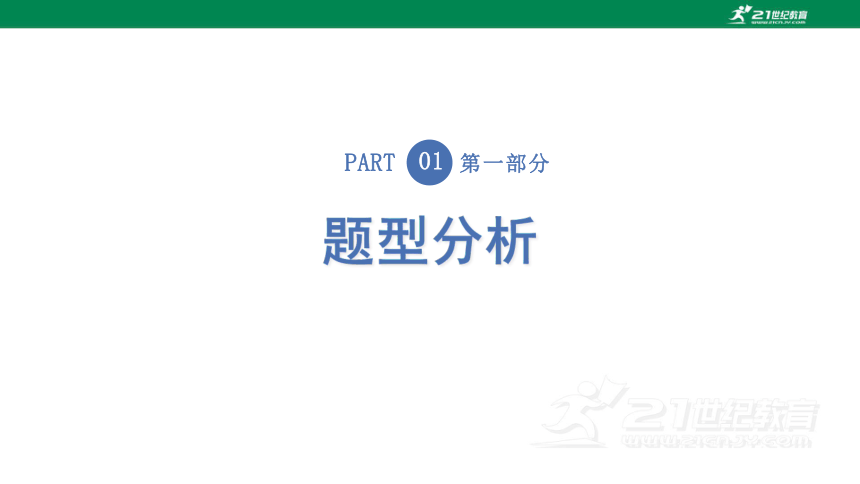
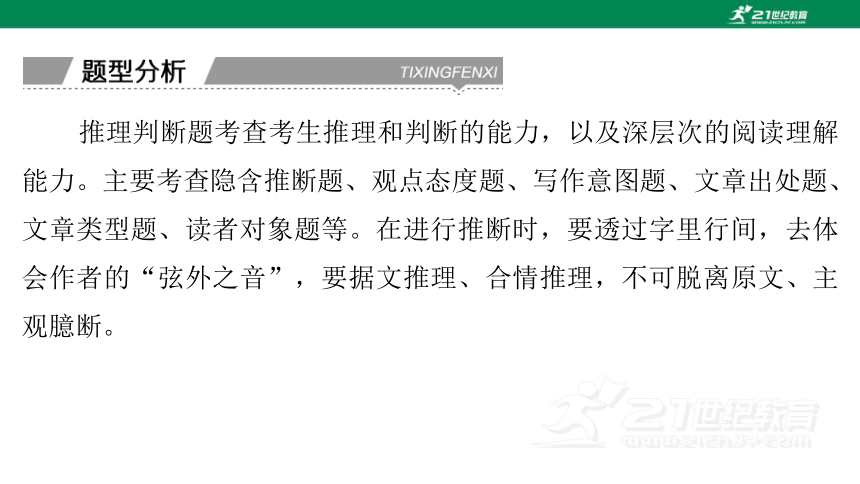
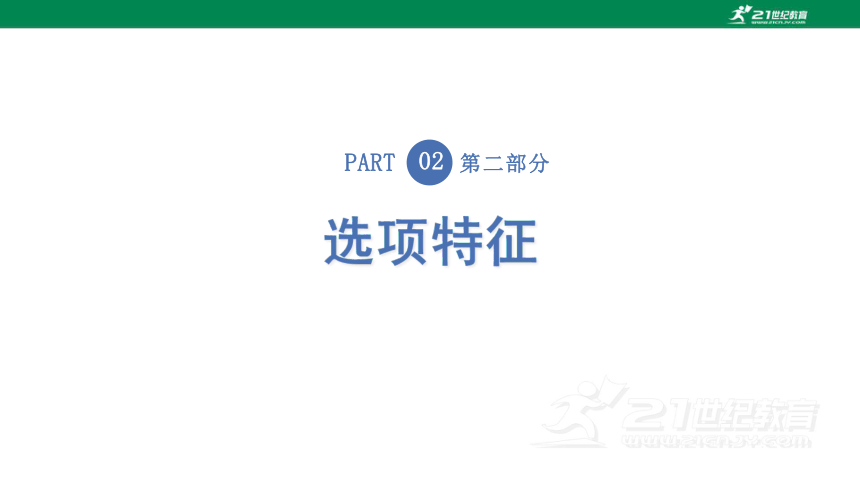
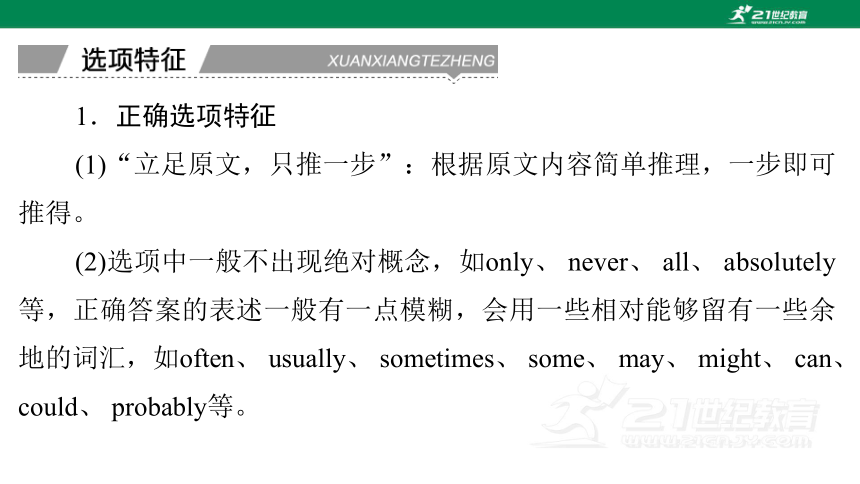

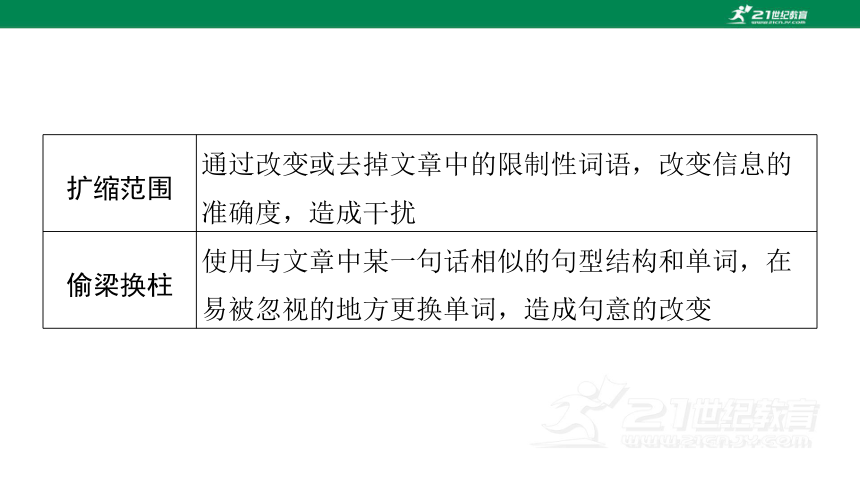
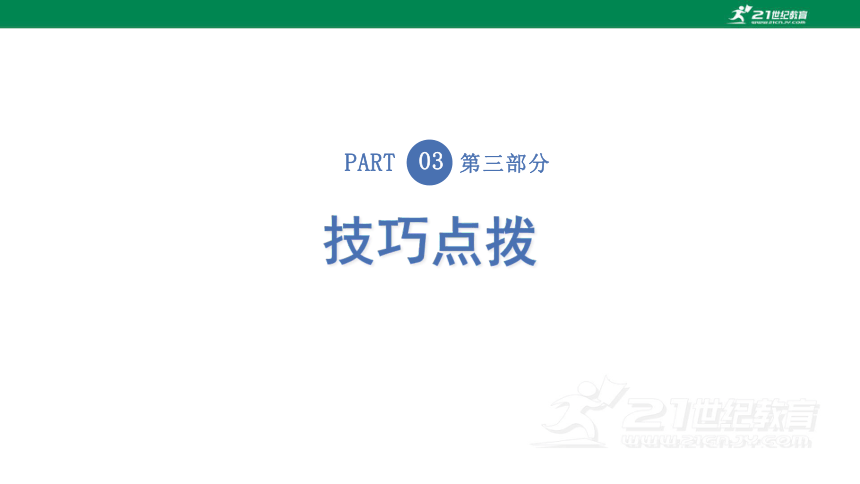
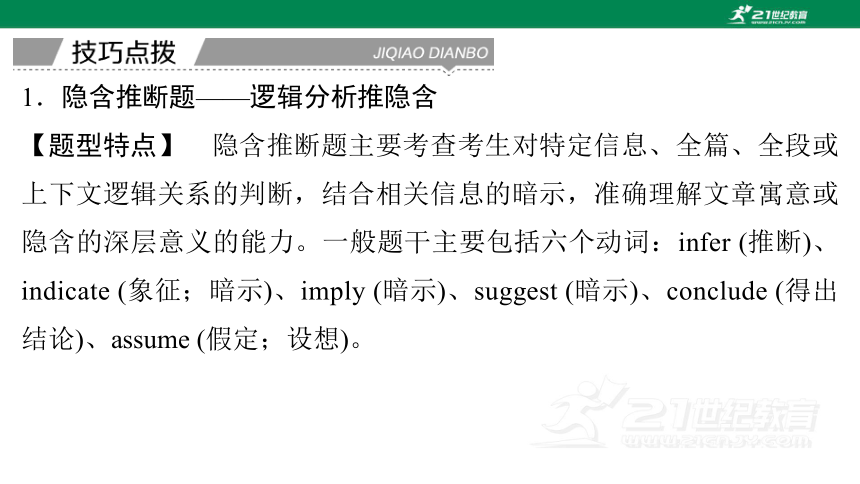
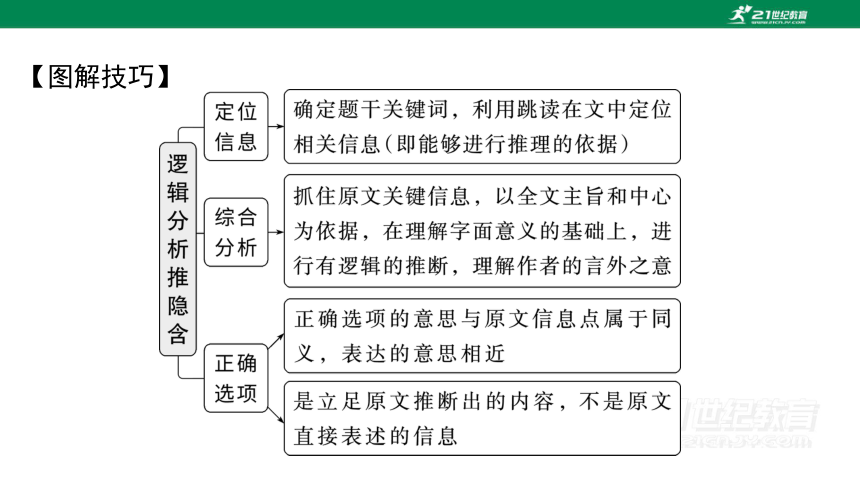
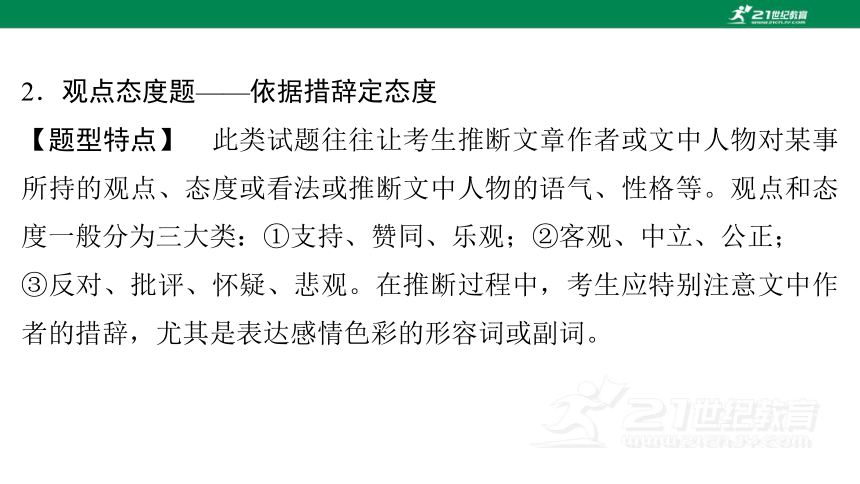
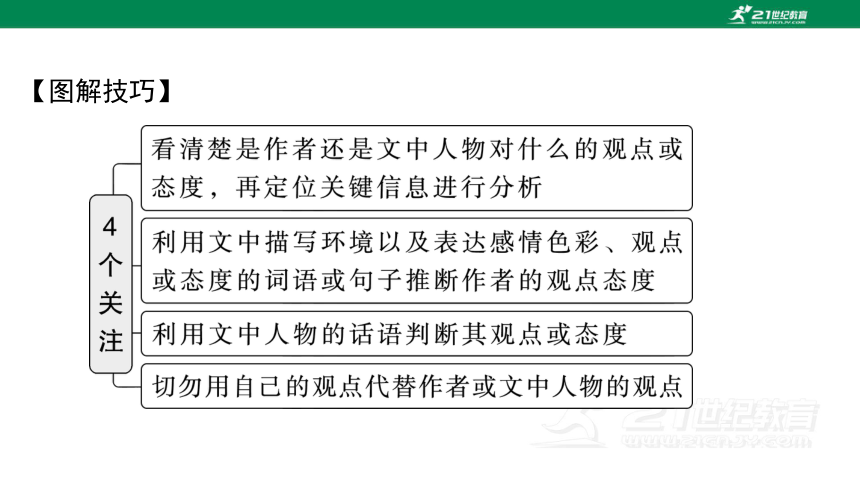
文档简介
(共40张PPT)
题型2 推理判断题
题型分析
PART
01
第一部分
推理判断题考查考生推理和判断的能力,以及深层次的阅读理解能力。主要考查隐含推断题、观点态度题、写作意图题、文章出处题、文章类型题、读者对象题等。在进行推断时,要透过字里行间,去体会作者的“弦外之音”,要据文推理、合情推理,不可脱离原文、主观臆断。
选项特征
PART
02
第二部分
1.正确选项特征
(1)“立足原文,只推一步”:根据原文内容简单推理,一步即可推得。
(2)选项中一般不出现绝对概念,如only、 never、 all、 absolutely等,正确答案的表述一般有一点模糊,会用一些相对能够留有一些余地的词汇,如often、 usually、 sometimes、 some、 may、 might、 can、 could、 probably等。
2.干扰选项特征
张冠李戴 把作者的观点与其他人的观点混在一起
无中生有 符合常识,但不是文章的内容
曲解文意 利用原文的内容进行设计,借题发挥,曲解原文意思;有些符合常识,但不符合文意
扩缩范围 通过改变或去掉文章中的限制性词语,改变信息的准确度,造成干扰
偷梁换柱 使用与文章中某一句话相似的句型结构和单词,在易被忽视的地方更换单词,造成句意的改变
技巧点拨
PART
03
第三部分
1.隐含推断题——逻辑分析推隐含
【题型特点】 隐含推断题主要考查考生对特定信息、全篇、全段或上下文逻辑关系的判断,结合相关信息的暗示,准确理解文章寓意或隐含的深层意义的能力。一般题干主要包括六个动词:infer (推断)、indicate (象征;暗示)、imply (暗示)、suggest (暗示)、conclude (得出结论)、assume (假定;设想)。
【图解技巧】
2.观点态度题——依据措辞定态度
【题型特点】 此类试题往往让考生推断文章作者或文中人物对某事所持的观点、态度或看法或推断文中人物的语气、性格等。观点和态度一般分为三大类:①支持、赞同、乐观;②客观、中立、公正;
③反对、批评、怀疑、悲观。在推断过程中,考生应特别注意文中作者的措辞,尤其是表达感彩的形容词或副词。
【图解技巧】
3.写作意图题——文体特点推意图
【题型特点】 各种话题的阅读材料都有可能考查写作意图题。通常情况下,作者在文中不直接陈述自己的意图,而是通过文中所列事物使读者感受到其所传递的想法。所以这种题型要求考生具备对作者阐述的内容进行总结和分析的能力。常见的设问方式有:
(1)What is the purpose of the passage
(2)The writer uses the example of...to ...
【图解技巧】
4.文章出处题、文章类型题、读者对象题——看内容推出处、类型和读者对象
【题型特点】 文章出处题、文章类型题要求考生具备一定的常识,能够根据文章的体裁和题材来推断文章的出处或类型。读者对象题要求考生根据文章内容和措辞推断文章的读者对象。常见的设问方式有:
(1)From which is the text probably taken
(2)The passage is probably intended for...
(3)What is the text
【图解技巧】
专题训练
PART
04
第四部分
Passage 1
(2020·广东1月)Our culture is the system we use to build our identity. All living things are part of a culture. Even animals have a culture! So what is culture It's the way we behave in a group. It begins with each individual (单个的) family. Within our families we do things to build relationships with each other. This can include routines like daily housework and weekly shopping. It also includes traditions. Traditions are activities that are repeated on a regular basis.
Culture is not limited to individual family groups. The real strength of culture is in larger community groups. These larger groups are called societies. Every society makes rules for itself. It decides how people should act in different situations. Some of these rules are written down. Some are just things that are naturally expected of all members of that society.
Often, cultures can be recognized by what the people believe. Cultures are also known by what they choose to include in their art. Sometimes cultures may be formed by people who speak the same language. Cultures may also be known for their customs, including the foods they make and the things they do.
Our cultures help us understand who we are and what we believe. There are very strong feelings connecting us to our own society. Two different cultures may disagree on something, especially if they both feel strongly about it. When that happens, war is a common result.
People are learning better ways to communicate with each other. The more we communicate, the more we appreciate the differences in cultures.
1.The underlined word “routines” in paragraph 1 is closest in meaning to ________.
A.hobbies B.behaviors
C.formal activities D.daily activities
词义猜测题。根据画线词后的“like daily housework and weekly shopping(像每天的家务活和每周购物)”可知,画线词routines的意思是“日常活动”。
√
2.Where does the real strength of culture live
A.In arts. B.In societies.
C.In families. D.In languages.
细节理解题。根据第二段中“The real strength of culture...are called societies.”可知,文化的真正力量在社会中。
√
3.Which of the following may the author disagree with according to the passage
A.Culture doesn't exist in animals.
B.Culture is the way we behave.
C.Cultures may not agree with each other.
D.Cultures help us understand ourselves.
推理判断题。根据第一段中“Even animals have a culture!”可知,作者在文中表达甚至动物都有文化,即文化不存在于动物中是作者不会认同的观点。
√
4.How can people appreciate cultural differences
A.By building a wall.
B.By preparing to fight.
C.By communicating.
D.By making friends.
推理判断题。根据最后一段“People are learning...the differences in cultures.”可推知,人们通过交流来欣赏文化差异。
√
5.What is the best title for the passage
A.What is Culture
B.What is Society
C.What is Tradition
D.What is System
标题归纳题。根据第一段中“Our culture is...in a group.”及下文内容可知,文章讲述了文化及其范畴。A项最适合作为本文的标题。
√
Passage 2
From the very beginning of school we make books and reading a constant source of possible failure and public humiliation. When children are little we make them read aloud, before the teacher and other children, so that we can be sure they “know” all the words they are reading. This means that when they don't know a word, they are going to make a mistake, right in front of everyone. After having taught fifth grade classes for four years, I decided to try at all costs to rid them of their fear and dislike of books, and to get them to read more often and more adventurously.
One day soon after school had started, I said to them, “Now I'm going to say something about reading that you have probably never heard a teacher say before. I would like you to read a lot of books this year, but I want you to read them only for pleasure. I am not going to ask you questions to find out whether you understand the books or not. If you understand enough of a book to enjoy it and want to go on reading it, that's enough for me. Also I'm not going to ask you what words mean.”
The children sat stunned and silent. Was this a teacher talking One girl, who had just come to us from a school where she had had a very hard time, looked at me steadily for a long time after I had finished. Then, still looking at me, she said slowly and seriously, “Mr Holt, do you really mean that?” I said just as seriously, “I mean every word of it.”
During the spring she really astonished me. One day, she was reading at her desk. From a glimpse of the illustrations I thought I knew what the book was. I said to myself, “It can't be,” and went to take a closer look. Sure enough, she was reading Moby Dick, in edition with woodcuts. I said, “Don't you find parts of it rather heavy going?” She answered, “Oh, sure, but I just skip over those parts and go on to the next good part.”
This is exactly what reading should be and in school so seldom is, an exciting, joyous adventure. Find something, dive into it, take the good parts, skip the bad parts, get what you can out of it, go on to something else. How different is our mean -spirited, picky insistence that every child get every last little scrap of “understanding” that can be dug out of a book.
【语篇解读】 本文是一篇记叙文。文章讲述了作者如何培养学生们的阅读能力。
1.According to the passage, what may be the cause of children's fear and dislike of books
A.Reading little and thinking little.
B.Reading often and adventurously.
C.Being made to read too much.
D.Being made to read aloud before others.
√
推理判断题。 根据第一段中的“When children are little we make them read aloud...are going to make a mistake, right in front of everyone.”可知,当孩子们还小的时候,让他们在老师和其他孩子面前大声朗读,就可以确保他们“知道”他们所读的所有单词。这意味着当他们有不认识的字的时候,他们会在所有人面前犯错误。由此可推知,孩子们对书的恐惧和厌恶可能是由于他们在别人面前大声朗读。
2.The teacher told his students to read________.
A.for enjoyment
B.for knowledge
C.for a larger vocabulary
D.for higher scores in exams
细节理解题。 根据第二段中的“but I want you to read them only for pleasure”可知,作者让他的学生们以阅读为乐。
√
3.Upon hearing the teacher's talk, how did the children probably feel
A.It sounded stupid.
B.It was not surprising at all.
C.It sounded too good to be true.
D.It was no different from other teachers' talk.
细节理解题。 根据第三段中的“The children sat stunned and silent.”和“do you really mean that”可知,孩子们都很震惊,很奇怪,不太相信老师所说的话。
√
4.Which of the following statements about the girl is TRUE according to the passage
A.She skipped over those easy parts while reading.
B.She had a hard time finishing the required reading tasks.
C.She learned to appreciate some parts of the difficult books.
D.She turned out to be a top student after coming to this school.
推理判断题。根据第四段最后一句可知,这个女孩跳过了那些很难的部分,继续读下一个好的部分。由此可推知,她学会了欣赏那些难读的书的某些部分。
√
5.From the teacher's point of view,________.
A.children cannot tell good parts from bad parts while reading
B.children should be left to decide what to read and how to read
C.reading is never a pleasant and inspiring experience in school
D.reading involves understanding every little piece of information
推理判断题。根据最后一段中的“Find something, dive into it, take the good parts, skip the bad parts, get what you can out of it, go on to something else.”可推知,从老师的角度看,应该让孩子们决定读什么和怎样读。
√
题型2 推理判断题
题型分析
PART
01
第一部分
推理判断题考查考生推理和判断的能力,以及深层次的阅读理解能力。主要考查隐含推断题、观点态度题、写作意图题、文章出处题、文章类型题、读者对象题等。在进行推断时,要透过字里行间,去体会作者的“弦外之音”,要据文推理、合情推理,不可脱离原文、主观臆断。
选项特征
PART
02
第二部分
1.正确选项特征
(1)“立足原文,只推一步”:根据原文内容简单推理,一步即可推得。
(2)选项中一般不出现绝对概念,如only、 never、 all、 absolutely等,正确答案的表述一般有一点模糊,会用一些相对能够留有一些余地的词汇,如often、 usually、 sometimes、 some、 may、 might、 can、 could、 probably等。
2.干扰选项特征
张冠李戴 把作者的观点与其他人的观点混在一起
无中生有 符合常识,但不是文章的内容
曲解文意 利用原文的内容进行设计,借题发挥,曲解原文意思;有些符合常识,但不符合文意
扩缩范围 通过改变或去掉文章中的限制性词语,改变信息的准确度,造成干扰
偷梁换柱 使用与文章中某一句话相似的句型结构和单词,在易被忽视的地方更换单词,造成句意的改变
技巧点拨
PART
03
第三部分
1.隐含推断题——逻辑分析推隐含
【题型特点】 隐含推断题主要考查考生对特定信息、全篇、全段或上下文逻辑关系的判断,结合相关信息的暗示,准确理解文章寓意或隐含的深层意义的能力。一般题干主要包括六个动词:infer (推断)、indicate (象征;暗示)、imply (暗示)、suggest (暗示)、conclude (得出结论)、assume (假定;设想)。
【图解技巧】
2.观点态度题——依据措辞定态度
【题型特点】 此类试题往往让考生推断文章作者或文中人物对某事所持的观点、态度或看法或推断文中人物的语气、性格等。观点和态度一般分为三大类:①支持、赞同、乐观;②客观、中立、公正;
③反对、批评、怀疑、悲观。在推断过程中,考生应特别注意文中作者的措辞,尤其是表达感彩的形容词或副词。
【图解技巧】
3.写作意图题——文体特点推意图
【题型特点】 各种话题的阅读材料都有可能考查写作意图题。通常情况下,作者在文中不直接陈述自己的意图,而是通过文中所列事物使读者感受到其所传递的想法。所以这种题型要求考生具备对作者阐述的内容进行总结和分析的能力。常见的设问方式有:
(1)What is the purpose of the passage
(2)The writer uses the example of...to ...
【图解技巧】
4.文章出处题、文章类型题、读者对象题——看内容推出处、类型和读者对象
【题型特点】 文章出处题、文章类型题要求考生具备一定的常识,能够根据文章的体裁和题材来推断文章的出处或类型。读者对象题要求考生根据文章内容和措辞推断文章的读者对象。常见的设问方式有:
(1)From which is the text probably taken
(2)The passage is probably intended for...
(3)What is the text
【图解技巧】
专题训练
PART
04
第四部分
Passage 1
(2020·广东1月)Our culture is the system we use to build our identity. All living things are part of a culture. Even animals have a culture! So what is culture It's the way we behave in a group. It begins with each individual (单个的) family. Within our families we do things to build relationships with each other. This can include routines like daily housework and weekly shopping. It also includes traditions. Traditions are activities that are repeated on a regular basis.
Culture is not limited to individual family groups. The real strength of culture is in larger community groups. These larger groups are called societies. Every society makes rules for itself. It decides how people should act in different situations. Some of these rules are written down. Some are just things that are naturally expected of all members of that society.
Often, cultures can be recognized by what the people believe. Cultures are also known by what they choose to include in their art. Sometimes cultures may be formed by people who speak the same language. Cultures may also be known for their customs, including the foods they make and the things they do.
Our cultures help us understand who we are and what we believe. There are very strong feelings connecting us to our own society. Two different cultures may disagree on something, especially if they both feel strongly about it. When that happens, war is a common result.
People are learning better ways to communicate with each other. The more we communicate, the more we appreciate the differences in cultures.
1.The underlined word “routines” in paragraph 1 is closest in meaning to ________.
A.hobbies B.behaviors
C.formal activities D.daily activities
词义猜测题。根据画线词后的“like daily housework and weekly shopping(像每天的家务活和每周购物)”可知,画线词routines的意思是“日常活动”。
√
2.Where does the real strength of culture live
A.In arts. B.In societies.
C.In families. D.In languages.
细节理解题。根据第二段中“The real strength of culture...are called societies.”可知,文化的真正力量在社会中。
√
3.Which of the following may the author disagree with according to the passage
A.Culture doesn't exist in animals.
B.Culture is the way we behave.
C.Cultures may not agree with each other.
D.Cultures help us understand ourselves.
推理判断题。根据第一段中“Even animals have a culture!”可知,作者在文中表达甚至动物都有文化,即文化不存在于动物中是作者不会认同的观点。
√
4.How can people appreciate cultural differences
A.By building a wall.
B.By preparing to fight.
C.By communicating.
D.By making friends.
推理判断题。根据最后一段“People are learning...the differences in cultures.”可推知,人们通过交流来欣赏文化差异。
√
5.What is the best title for the passage
A.What is Culture
B.What is Society
C.What is Tradition
D.What is System
标题归纳题。根据第一段中“Our culture is...in a group.”及下文内容可知,文章讲述了文化及其范畴。A项最适合作为本文的标题。
√
Passage 2
From the very beginning of school we make books and reading a constant source of possible failure and public humiliation. When children are little we make them read aloud, before the teacher and other children, so that we can be sure they “know” all the words they are reading. This means that when they don't know a word, they are going to make a mistake, right in front of everyone. After having taught fifth grade classes for four years, I decided to try at all costs to rid them of their fear and dislike of books, and to get them to read more often and more adventurously.
One day soon after school had started, I said to them, “Now I'm going to say something about reading that you have probably never heard a teacher say before. I would like you to read a lot of books this year, but I want you to read them only for pleasure. I am not going to ask you questions to find out whether you understand the books or not. If you understand enough of a book to enjoy it and want to go on reading it, that's enough for me. Also I'm not going to ask you what words mean.”
The children sat stunned and silent. Was this a teacher talking One girl, who had just come to us from a school where she had had a very hard time, looked at me steadily for a long time after I had finished. Then, still looking at me, she said slowly and seriously, “Mr Holt, do you really mean that?” I said just as seriously, “I mean every word of it.”
During the spring she really astonished me. One day, she was reading at her desk. From a glimpse of the illustrations I thought I knew what the book was. I said to myself, “It can't be,” and went to take a closer look. Sure enough, she was reading Moby Dick, in edition with woodcuts. I said, “Don't you find parts of it rather heavy going?” She answered, “Oh, sure, but I just skip over those parts and go on to the next good part.”
This is exactly what reading should be and in school so seldom is, an exciting, joyous adventure. Find something, dive into it, take the good parts, skip the bad parts, get what you can out of it, go on to something else. How different is our mean -spirited, picky insistence that every child get every last little scrap of “understanding” that can be dug out of a book.
【语篇解读】 本文是一篇记叙文。文章讲述了作者如何培养学生们的阅读能力。
1.According to the passage, what may be the cause of children's fear and dislike of books
A.Reading little and thinking little.
B.Reading often and adventurously.
C.Being made to read too much.
D.Being made to read aloud before others.
√
推理判断题。 根据第一段中的“When children are little we make them read aloud...are going to make a mistake, right in front of everyone.”可知,当孩子们还小的时候,让他们在老师和其他孩子面前大声朗读,就可以确保他们“知道”他们所读的所有单词。这意味着当他们有不认识的字的时候,他们会在所有人面前犯错误。由此可推知,孩子们对书的恐惧和厌恶可能是由于他们在别人面前大声朗读。
2.The teacher told his students to read________.
A.for enjoyment
B.for knowledge
C.for a larger vocabulary
D.for higher scores in exams
细节理解题。 根据第二段中的“but I want you to read them only for pleasure”可知,作者让他的学生们以阅读为乐。
√
3.Upon hearing the teacher's talk, how did the children probably feel
A.It sounded stupid.
B.It was not surprising at all.
C.It sounded too good to be true.
D.It was no different from other teachers' talk.
细节理解题。 根据第三段中的“The children sat stunned and silent.”和“do you really mean that”可知,孩子们都很震惊,很奇怪,不太相信老师所说的话。
√
4.Which of the following statements about the girl is TRUE according to the passage
A.She skipped over those easy parts while reading.
B.She had a hard time finishing the required reading tasks.
C.She learned to appreciate some parts of the difficult books.
D.She turned out to be a top student after coming to this school.
推理判断题。根据第四段最后一句可知,这个女孩跳过了那些很难的部分,继续读下一个好的部分。由此可推知,她学会了欣赏那些难读的书的某些部分。
√
5.From the teacher's point of view,________.
A.children cannot tell good parts from bad parts while reading
B.children should be left to decide what to read and how to read
C.reading is never a pleasant and inspiring experience in school
D.reading involves understanding every little piece of information
推理判断题。根据最后一段中的“Find something, dive into it, take the good parts, skip the bad parts, get what you can out of it, go on to something else.”可推知,从老师的角度看,应该让孩子们决定读什么和怎样读。
√
同课章节目录
